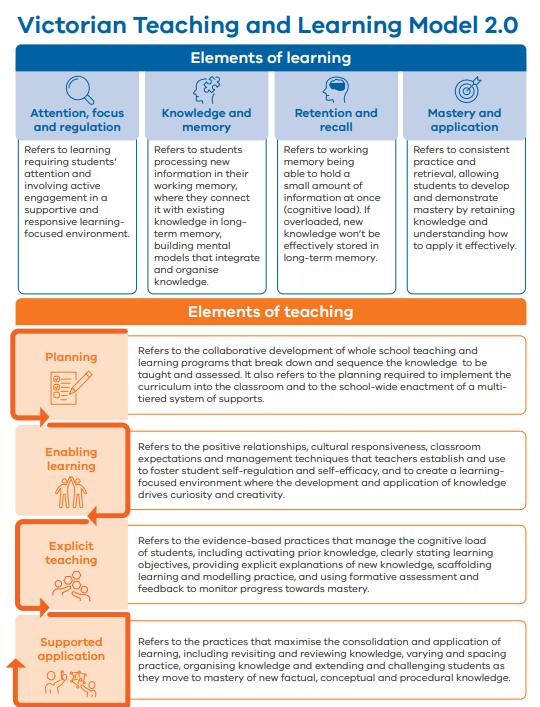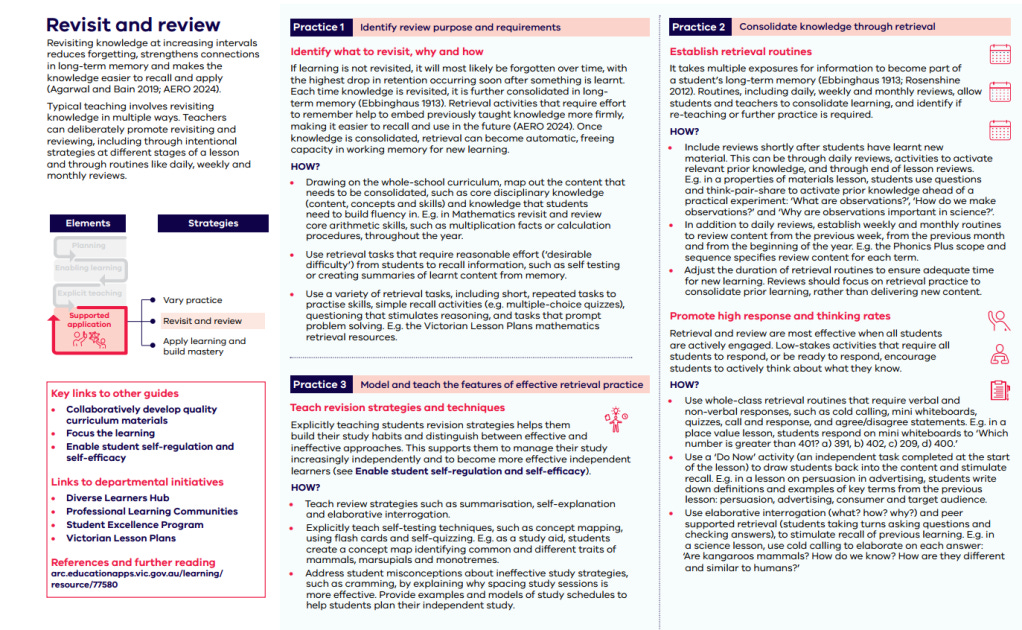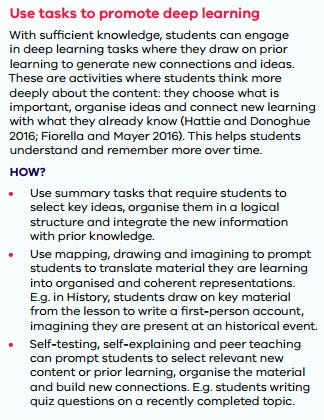If They Don’t Bring It Back, It Won’t Stick
‘Retrieval’ is everywhere right now and for good reason. It’s not shiny or new. It’s not a silver bullet. It’s just good teaching - grounded in years of research on how learning works.
Daniel Willingham says we remember what we think about — and retrieval helps students do that thinking.
John Sweller reminds us that memory is limited. Retrieval helps focus attention where it matters.
Barak Rosenshine says start with review, guide the practice, ask lots of questions. That’s retrieval.
Paul Kirschner Retrieval gives all students a better shot.
The Bjorks talk about how effort helps learning stick. That little bit of struggle is what makes retrieval work.
It’s built into the new Victorian Teaching and Learning Model 2.0 here in Australia, and I’m proud to be part of a system that recognises its value. Retrieval (within Supported Application) is one of the four Elements of Teaching. Let’s look at how it’s woven into the model.
The Revisit and Review guide within VTLM 2.0 makes this clear: retrieval isn’t an add-on. It’s part of what effective teaching looks like every day.
Retrieval is about getting students to bring back what they’ve already learned. It helps strengthen their memory and keeps learning from slipping away. It’s not about catching them out or testing for marks. It’s about helping them think.
This post builds on the ideas I wrote about in a previous post - Teaching Awake about being clear, deliberate, and always paying attention to how students are thinking. Retrieval is part of that. If we want learning to last, we need to help students bring it back often.
It’s not about grades
When people hear retrieval, they often picture a test. But that misses the point. Retrieval isn’t about grades. It’s about helping learning stick. It’s not something we do to check what students know, it’s something we do to help them remember.
Retrieval doesn’t need to be formal or marked. In fact, it works best when it’s low-stakes and built into everyday routines. It helps move learning from short-term memory to long-term memory, which is what we want if we want learning to last.
The VTLM 2.0 Revisit and Review guide makes this really clear:
"Retrieval activities that require effort to remember help to embed previously taught knowledge more firmly."
If we want students to hold onto learning, we have to give them chances to bring it back. Not once. Again and again.
How learning happens
Learning doesn’t happen just because we’ve explained something. It happens when students think about it, connect it to what they already know, and bring it back more than once. Cognitive science tells us that working memory is limited. If we overload it, not much sticks. That’s where retrieval comes in.
Clear teaching, modelling, and retrieval help students focus on what matters. That’s the heart of cognitive load theory. We want to take away the distractions and keep the challenge that actually helps learning happen.
Researchers like Sweller, Kirschner, and Willingham have been writing about this for years. If we want learning to last, we need to make sure students are thinking about the right things and not too many things at once.
The forgetting curve
Image (and article) from Teach like a Champion, adapted from a drawing by the amazing Oliver Caviglioli.
Students forget. We all do. The forgetting curve, first shown by Ebbinghaus, shows how quickly we lose new learning if we don’t bring it back. Sometimes even the next day is too late.
Retrieval interrupts forgetting. Every time students bring something back to mind, the memory gets stronger. If we space those opportunities out, the effect is even better. That’s why we don’t just do retrieval at the end of a unit. We need to do it across lessons and weeks.
This is called the spacing effect. It works.
How to ensure your reviews are purposeful
Inspired by Doug Lemov, Kate Jones, VTLM 2.0, and the work of cognitive scientists like the Bjorks and Kirschner.
Retrieval works best when it’s planned with purpose. You don’t need to guess what to include. There are some simple ways to balance recency and long-term review.
One approach is the 3:2:1 method:
3 prompts from yesterday or last week
2 from earlier this term
1 from a past unit or term
You could also use something like the RECAP structure:
Recent learning (yesterday)
Early unit content (last week)
Core ideas that always matter
Application-style prompt (use the idea in a new way)
Prior-year connection (bring back something big)
The VTLM 2.0 Revisit and Review guide also gives clear direction:
Include content from yesterday’s lesson
Pull in key ideas students often forget or confuse
Revisit content from earlier in the term
Make sure it connects to the current focus
The goal is to space things out, mix things up, and bring important ideas back often. You can use lesson starters, fluency work, whiteboards, partner talk, exit tickets, choral responses -whatever fits the moment. What matters is that it happens often and with purpose.
What it looks like in practice
In my classroom, retrieval shows up in lots of ways, some quick and familiar, others built into how we plan:
Daily reviews: We begin most lessons with a quick recap of prior learning similar to the 3:2:1. Nothing fancy. Just a chance to bring it back (OCHRE daily review slides help with the planning of this!).
Mini whiteboards: Ask a question. Think time. Write. Show. I get a read on the room straight away.
Fluency passages: This helps make review of prior content feel natural. it’s retrieval without it feeling like revision.
Use the room: Anchor charts, word walls, and posters help students revisit key ideas like adverbs, sentence types, or vocabulary (just make sure they aren't adding to extraneous load - so try to position them towards the back of the room).
Go back to go forward: Students use their own workbooks to look back at what we’ve done. Sometimes I ask them to prep a short summary or explanation to share.
Scope and sequence that revisits: Our units don’t just move on. They loop back to earlier content. We bring old learning into new lessons on purpose.
Exit tickets and transition questions: We use small moments like when lining up, or a quick entry into the classroom question to bring things back with a quick recall prompt.
Retrieval isn’t something we do once. It’s built into how we teach, how we plan, and how we use our space.
We also plan for retrieval across time. We don’t just revisit things the next day. We come back to them weeks later. That’s how students build fluency and confidence.
Why knowledge still matters.
Retrieval builds knowledge. But knowledge isn’t the end goal, it’s the foundation. That’s how students move from remembering to applying, explaining, and problem solving.
That’s what transfer is. And it only works when the knowledge is strong enough to be pulled back and used. The Apply Learning and Build Mastery guide in VTLM 2.0 highlights this. First we build knowledge. Then we build on it more.
Retrieval is a mindset
The biggest shift for me has been seeing retrieval not as a task, but as a way of thinking. It shows up in everything now.
It’s changed how I plan and how I teach. And it’s helped students feel more confident. They’re remembering more because they’re thinking more.
It might look like a quiz. But it could also be a mini-whiteboard. A conversation. A quick question during a transition.
Retrieval isn’t one more thing. It’s the thing that helps everything else stick.







